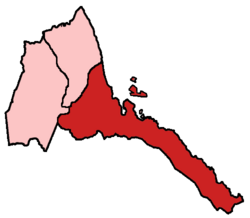
An exarch was the holder of any of various historical offices, some of them being political or military and others being ecclesiastical.
A titular see in various churches is an episcopal see of a former diocese that no longer functions, sometimes called a "dead diocese". The ordinary or hierarch of such a see may be styled a "titular metropolitan", "titular archbishop" or "titular bishop", which normally goes by the status conferred on the titular see.
Sui iuris, also spelled sui juris, is a Latin phrase that literally means "of one's own right". It is used in both the Catholic Church's canon law and secular law. The term church sui iuris is used in the Catholic Code of Canons of the Eastern Churches (CCEO) to denote the autonomous churches in Catholic communion. The Catholic Church consists of 24 churches, including the Latin Church and 23 Eastern Catholic churches.
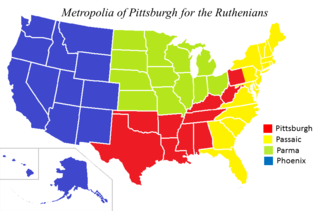
The Metropolis of Pittsburgh is a sui juris metropolitan see of the Ruthenian Greek Catholic Church that is located in the United States of America and Canada. The Ruthenian Greek Catholic Church is one of 23 sui juris Eastern Catholic particular churches in the Catholic Church that is in full communion with the Holy See. The metropolis uses the Byzantine Rite in its liturgies. It was erected as a metropolis (archdiocese) by Pope Paul VI in 1969. The metropolis has jurisdiction over those communities that originated from the regions of Carpathian Ruthenia, Slovakia, Hungary and the former Yugoslavia. Worshipers come from several Byzantine Catholic groups: Rusyn Americans, Slovak Americans, Hungarian Americans, and Croatian Americans. In 2022, governance of the Exarchate of Saints Cyril and Methodius of Toronto in Canada passed to the metropolis of Pittsburgh from the Slovak Greek Catholic Church.
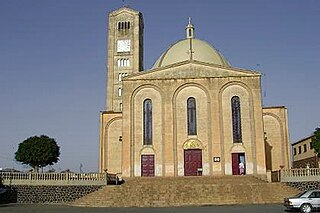
The Eritrean Catholic Church or Eritrean Eastern Catholic Church is a sui iuris (autonomous) Eastern Catholic church based in Eritrea. As a particular church of the Catholic Church, it is in full communion with the Holy See. It was established in 2015 when its territory was separated from the Ethiopian Catholic Church. The church is organized under a metropolitan bishop who exercises oversight of a number of suffragan dioceses. In its liturgical services, it uses the Alexandrian Rite in the Ge'ez language.

The Ethiopian Catholic Church or Ethiopian Eastern Catholic Church is a sui iuris (autonomous) Eastern Catholic church that is based in Ethiopia. As a particular church of the Catholic Church, it is in full communion with the Holy See. Established in 1930, the church is organised under a metropolitan bishop who exercises oversight of a number suffragan dioceses. In its liturgical services, it uses the Alexandrian Rite in the Geʽez language.
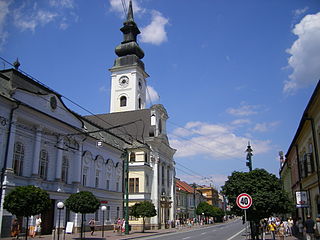
The Slovak Greek Catholic Church or Byzantine Catholic Church in Slovakia, is a sui iuris (autonomous) Eastern Catholic church based in Slovakia. As a particular church of the Catholic Church, it is in full communion with the Holy See. The church is organised as a single ecclesiastical province with one metropolitan see. Its liturgical rite is the Byzantine Rite. In 2008 in Slovakia alone, the Greek Catholic Church in Slovakia had some 350,000 faithful, 374 priests and 254 parishes. In 2017, the Catholic Church counted 207,320 Greek Catholics in Slovakia worldwide, representing roughly one percent of all Eastern Catholics.

Eritrea as a country and the Eritrean community are multi-religious. Eritrea has two dominant religions, Christianity and Islam.

The Ethiopian Catholic Archeparchy of Addis Abeba, officially the Metropolitan sui iuris Archeparchy of Addis Abeba is the metropolitan see of the Ethiopian Catholic Church, a sui iuris metropolitan Eastern Catholic Church.

The Eparchy of Križevci is a Greek Catholic Church of Croatia and Serbia eparchy of the Catholic Church in Croatia, Slovenia, and Bosnia and Herzegovina. Its current eparch is Milan Stipić. The cathedra is in the Cathedral of the Holy Trinity, in the episcopal see of Križevci, Croatia.
A particular church is an ecclesiastical community of followers headed by a bishop, as defined by Catholic canon law and ecclesiology. A liturgical rite, a collection of liturgies descending from shared historic or regional context, depends on the particular church the bishop belongs to. Thus the term "particular church" refers to an institution, and "liturgical rite" to its ritual practices.

Menghesteab Tesfamariam, M.C.C.I. is an Eritrean Catholic prelate who has served as the Metropolitan Archbishop of Asmara and head of the Eritrean Catholic Church since 2015. He is a member of the Comboni Missionaries and has been a bishop since 2001.
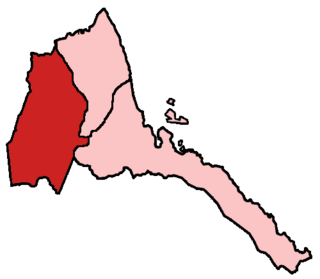
The Eritrean Catholic Eparchy of Barentu is a Catholic eparchy located in the town of Barentu in Eritrea. It is a part of the ecclesiastical province of Asmara.

The Eritrean Catholic Eparchy of Keren is a Roman Catholic eparchy centred in the city of Keren in Eritrea. It is a suffragan of the Archeparchy of Asmara, and a constituent eparchy of the Eritrean Catholic Church.
The Eritrean Catholic Eparchy of Segheneyti is a Catholic eparchy located in the town of Segheneyti in Eritrea. It is a part of the ecclesiastical province of Asmara. The eparchy follows the Alexandrian Rite, and has a cathedral of Saint Michael the Archangel.

The Apostolic Vicariate of Asmara was a Roman Catholic missionary jurisdiction in Eritrea. Centered in Asmara it was at first the Apostolic Prefecture of Eritrea and then the Apostolic Vicariate of Eritrea.

The Eparchy of Miskolc is an eparchy (diocese) of the Hungarian Greek Catholic Church which is a particular church sui iuris of the Catholic Church. It uses the Byzantine Rite in the Hungarian language in its liturgical services.

